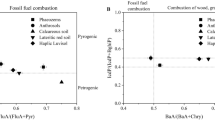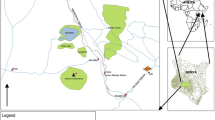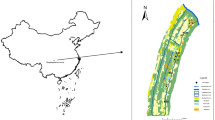Abstract
Polycyclic aromatic hydrocarbons (PAHs) are ubiquitous soil contaminants, and their bioaccessibility determines their environmental risks in contaminated land. In the present study, the residual concentrations of PAHs in the soils of two industrial sites were determined, and their bioaccessibility was estimated by the hydroxypropyl-β-cyclodextrin extraction (HPCD) extraction method. The results showed heavy PAH contamination at both site S1 (0.38–3342.5 mg kg−1) and site S2 (0.2–138.18 mg kg−1), of which high molecular weight (HMW) PAHs (4-, 5-, and 6-ring compounds) accounted for approximately 80%. The average bioaccessibility of PAHs at sites S1 and S2 was 52.02% and 29.28%, respectively. The bioaccessibility of certain PAH compounds decreased with increasing ring number of the molecule. Lower PAH bioaccessibility was detected in loamy and silty soil textures than in sandy soil. Moreover, among the soil properties, the dissolved organic matter, total organic carbon, total potassium, and total manganese concentrations had significant effects on the bioaccessibility of PAHs. The toxicity analysis showed that the composition and bioaccessibility of PAHs could affect their potential toxicity in soil. We suggest that bioaccessibility should be taken into consideration when assessing the toxicity of PAHs in soil, and more attention should be given to low-ring PAHs with high bioaccessibility.




Similar content being viewed by others
References
Achten C, Cheng SB, Straub KL et al (2011) The lack of microbial degradation of polycyclic aromatic hydrocarbons from coal-rich soils. Environ Pollut 159:623–629
Anderson CJ (2013) Degradation and composition of polycyclic aromatic hydrocarbons (PAHs) following oil exposure in experimental salt marshes. Water Air Soil Pollut 224:1608
Cheng Y, Sun H, Yang ET et al (2021) Distribution and bioaccessibility of polycyclic aromatic hydrocarbons in industrially contaminated site soils as affected by thermal treatment. J Hazard Mater 411:125129
Chung N, Alexander M (2002) Effect of soil properties on bioavailability and extractability of phenanthrene and atrazine sequestered in soil. Chemosphere 48:109–115
Crampon M, Bodilis J, Le Derf F et al (2016) Alternative techniques to HPCD to evaluate the bioaccessible fraction of soil-associated PAHs and correlation to biodegradation efficiency. J Hazard Mater 314:220–229
Cvancarova M, Kresinova Z, Cajthaml T (2013) Influence of the bioaccessible fraction of polycyclic aromatic hydrocarbons on the ecotoxicity of historically contaminated soils. J Hazard Mater 254:116–124
Dat ND, Chang MB (2017) Review on characteristics of PAHs in atmosphere, anthropogenic sources and control technologies. Sci Total Environ 609:682–693
Duan LC, Palanisami T, Liu YJ et al (2014) Effects of ageing and soil properties on the oral bioavailability of benzo[a]pyrene using a swine model. Environ Int 70:192–202
Duran R, Cravo-Laureau C (2016) Role of environmental factors and microorganisms in determining the fate of polycyclic aromatic hydrocarbons in the marine environment. Fems Microbiol Rev 40:814–830
Gao GY, Fu BJ, Zhan HB et al (2013) Contaminant transport in soil with depth-dependent reaction coefficients and time-dependent boundary conditions. Water Res 47:2507–2522
Gao P, Li HB, Wilson CP et al (2018) Source identification of PAHs in soils based on stable carbon isotopic signatures. Crit Rev Environ Sci Technol 48:923–948
Gao P, da Silva EB, Townsend T et al (2019) Emerging PAHs in urban soils: concentrations, bioaccessibility, and spatial distribution. Sci Total Environ 670:800–805
Han XM, Liu YR, Zheng YM et al (2014) Response of bacterial pdo1, nah, and C12O genes to aged soil PAH pollution in a coke factory area. Environ Sci Pollut Res 21:9754–9763
Han D, Jiang L, Zhong MS et al (2020) Desorption and bioaccessibility of high-molecular-weight PAHs in aged field soil and humin-like fraction from a coke plant. Environ Earth Sci 79:243
Hindersmann B, Achten C (2018) Urban soils impacted by tailings from coal mining: PAH source identification by 59 PAHs, BPCA and alkylated PAHs. Environ Pollut 242:1217–1225
Humel S, Schritter J, Sumetzberger-Hasinger M et al (2020) Atmospheric carbonation reduces bioaccessibility of PAHs in industrially contaminated soil. J Hazard Mater 383:121092
Idowu O, Semple KT, Ramadass K et al (2020) Analysis of polycyclic aromatic hydrocarbons (PAHs) and their polar derivatives in soils of an industrial heritage city of Australia. Sci Total Environ 699:134303
Jia JP, Bi CJ, Zhang JF et al (2019) Atmospheric deposition and vegetable uptake of polycyclic aromatic hydrocarbons (PAHs) based on experimental and computational simulations. Atmos Environ 204:135–141
Karaca G (2016) Spatial distribution of polycyclic aromatic hydrocarbon (PAH) concentrations in soils from Bursa, Turkey. Arch Environ Contam Toxicol 70:406–417
Knight ER, Janik LJ, Navarro DA et al (2019) Predicting partitioning of radiolabelled C-14-PFOA in a range of soils using diffuse reflectance infrared spectroscopy. Sci Total Environ 686:505–513
Leech C, Tighe MK, Pereg L et al (2020) Bioaccessibility constrains the co-composting bioremediation of field aged PAH contaminated soils. Int Biodeterior Biodegrad 149:104922
Li F, Guo S, Hartog N (2012) Electrokinetics-enhanced biodegradation of heavy polycyclic aromatic hydrocarbons in soil around iron and steel industries. Electrochim Acta 85:228–234
Li XJ, Shuang SQ, Li XY et al (2013) The effect of concentrations and properties of phenanthrene, pyrene, and benzo(a)pyrene on desorption in contaminated soil aged for 1 year. J Soils Sediments 13:375–382
Li Z, Zhang W, Shan B (2022) Effects of organic matter on polycyclic aromatic hydrocarbons in riverine sediments affected by human activities. Sci Total Environ 815:152570
Liang X, Zhu LZ, Zhuang SL (2016) Sorption of polycyclic aromatic hydrocarbons to soils enhanced by heavy metals: perspective of molecular interactions. J Soils Sediments 16:1509–1518
Lin Q, Shen KL, Zhao HM et al (2008) Growth response of Zea mays L. in pyrene-copper co-contaminated soil and the fate of pollutants. J Hazard Mater 150:515–521
Luo L, Zhang S, Christie P (2010) New insights into the influence of heavy metals on phenanthrene sorption in soils. Environ Sci Technol 44:7846–7851
Moeckel C, Monteith DT, Llewellyn NR et al (2014) Relationship between the concentrations of dissolved organic matter and polycyclic aromatic hydrocarbons in a typical UK upland stream. Environ Sci Technol 48:130–138
Nadal M, Schuhmacher M, Domingo JL (2004) Levels of PAHs in soil and vegetation samples from Tarragona County, Spain. Environ Pollut 132:1–11
Ni N, Shi RY, Liu ZT et al (2018) Effects of biochars on the bioaccessibility of phenanthrene/pyrene/zinc/lead and microbial community structure in a soil under aerobic and anaerobic conditions. J Environ Sci 63:296–306
Nisbet I, Lagoy P (1992) Toxic equivalency factors (TEFs) for polycyclic aromatic-hydrocarbons (PAHs). Regul Toxicol Pharmacol 16:290–300
Oleszczuk P, Godlewska P, Reible DD et al (2017) Bioaccessibility of polycyclic aromatic hydrocarbons in activated carbon or biochar amended vegetated (Salix viminalis) soil. Environ Pollut 227:406–413
Ortega-Calvo JJ, Harmsen J, Parsons JR et al (2015) From bioavailability science to regulation of organic chemicals. Environ Sci Technol 49:10255–10264
Portet-Koltalo F, Gardes T, Debret M et al (2020) Bioaccessibility of polycyclic aromatic compounds (PAHs, PCBs) and trace elements: influencing factors and determination in a river sediment core. J Hazard Mater 384:121499
Princz J, Jatar M, Lemieux H et al (2018) Perfluorooctane sulfonate in surface soils: effects on reproduction in the collembolan, folsomia candida, and the oribatid mite, oppia nitens. Chemosphere 208:757–763
Pu XZ, Lee LS, Galinsky RE et al (2004) Evaluation of a rat model versus a physiologically based extraction test for assessing phenanthrene bioavailability from soils. Toxicol Sci 79:10–17
Qin SB, Qi SH, Li XS et al (2020) Magnetic solid-phase extraction as a novel method for the prediction of the bioaccessibility of polycyclic aromatic hydrocarbons. Sci Total Environ 728:138789
Reid BJ, Stokes JD, Jones KC et al (2000) Nonexhaustive cyclodextrin-based extraction technique for the evaluation of PAH bioavailability. Environ Sci Technol 34:3174–3179
Richter-Brockmann S, Achten C (2018) Analysis and toxicity of 59 PAH in petrogenic and pyrogenic environmental samples including dibenzopyrenes, 7H-benzo[c] fluorene, 5-methylchrysene and 1-methylpyrene. Chemosphere 200:495–503
Ritore E, Coquelet B, Arnaiz C et al (2022) Guidelines for surfactant selection to treat petroleum hydrocarbon-contaminated soils. Environ Sci Pollut Res 29:7639–7651
Sabate J, Vinas M, Solanas AM (2006) Bioavailability assessment and environmental fate of polycyclic aromatic hydrocarbons in biostimulated creosote-contaminated soil. Chemosphere 63:1648–1659
Saeedi M, Li LY, Grace JR (2018) Effect of organic matter and selected heavy metals on sorption of acenaphthene, fluorene and fluoranthene onto various clays and clay minerals. Environ Earth Sci 77:305
Saison C, Perrin-Ganier C, Amellal S et al (2004) Effect of metals on the adsorption and extractability of C-14-phenanthrene in soils. Chemosphere 55:477–485
Semple KT, Doick KJ, Jones KC et al (2004) Defining bioavailability and bioaccessibility of contaminated soil and sediment is complicated. Environ Sci Technol 38:228–231
Si YB, Takagi K, Iwasaki A et al (2009) Adsorption, desorption and dissipation of metolachlor in surface and subsurface soils. Pest Manag Sci 65:956–962
Siemering GS, Thiboldeaux R (2021) Background concentration, risk assessment and regulatory threshold development: polycyclic aromatic hydrocarbons (PAH) in Milwaukee. Wisconsin Surf Soils Environ Pollut 268:115772
Tao S, Xu FL, Liu WX et al (2006) A chemical extraction method for mimicking bioavailability of polycyclic aromatic hydrocarbons to wheat grown in soils containing various amounts of organic matter. Environ Sci Technol 40:2219–2224
Tian K, Bao HY, Zhang XC et al (2018) Residuals, bioaccessibility and health risk assessment of PAHs in winter wheat grains from areas influenced by coal combustion in China. Sci Total Environ 618:777–784
Tsibart AS, Gennadiev AN (2013) Polycyclic aromatic hydrocarbons in soils: sources, behavior, and indication significance (a review). Eurasian Soil Sci 46:728–741
Umeh AC, Duan L, Naidu R et al (2019) In vitro gastrointestinal mobilization and oral bioaccessibility of PAHs in contrasting soils and associated cancer risks: focus on PAH nonextractable residues. Environ Int 133:105186
Wang RW, Sun RW, Liu GJ et al (2017) A review of the biogeochemical controls on the occurrence and distribution of polycyclic aromatic compounds (PACs) in coals. Earth-Sci Rev 171:400–418
Wang C, Yang ZZ, Zhang YH et al (2018) PAHs and heavy metals in the surrounding soil of a cement plant co-processing hazardous waste. Chemosphere 210:247–256
Whittaker ML, Lammers LN, Carrero S et al (2019) Ion exchange selectivity in clay is controlled by nanoscale chemical-mechanical coupling. Proc Natl Acad Sci USA 116:22052–22057
Widdowson MA, Shearer S, Andersen RG et al (2003) Remediation of polycyclic aromatic hydrocarbon compounds in groundwater using poplar trees. Environ Sci Technol 39:1598–1605
Wilcke W (2007) Global patterns of polycyclic aromatic hydrocarbons (PAHs) in soil. Geoderma 141:157–166
Wilcke W, Zech W, Kobza J (1996) PAH-pools in soils along a PAH-deposition gradient. Environ Pollut 92:307–313
Wu Y, Salamova A, Venier M (2021) Using diagnostic ratios to characterize sources of polycyclic aromatic hydrocarbons in the Great Lakes atmosphere. Sci Total Environ 761:143240
Yu L, Vázquez-Cuevas G, Duan L et al (2016) Buffered cyclodextrin extraction of 14C-phenanthrene from black carbon amended soil. Environ Technol Innov 6:177–184
Yu LB, Duan LC, Naidu R et al (2018) Abiotic factors controlling bioavailability and bioaccessibility of polycyclic aromatic hydrocarbons in soil: putting together a bigger picture. Sci Total Environ 613:1140–1153
Zelinkova Z, Wenzl T (2015) The occurrence of 16 EPA PAHs in food—a review. Polycycl Aromat Compd 35:248–284
Zhang P, Chen YG (2017) Polycyclic aromatic hydrocarbons contamination in surface soil of China: a review. Sci Total Environ 605:1011–1020
Zhang J, Fan SK, Du XM et al (2015) Accumulation, allocation, and risk assessment of polycyclic aromatic hydrocarbons (PAHs) in soil-brassica chinensis system. PLoS ONE 10:e0115863
Zhang YN, Yang XL, Gu CG et al (2016) A novel bioaccessibility prediction method for PAHs in soil: composite extraction with hydroxypropyl-beta-cyclodextrin and extracellular polymer substances. Sci Total Environ 569:997–1003
Zhang YN, Yang XL, Gu CG et al (2017) Prediction of polycyclic aromatic hydrocarbon bioaccessibility to earthworms in spiked soils by composite extraction with hydroxypropy1-beta-cyclodextrin and organic acids. Pedosphere 27:502–510
Acknowledgements
This study was financially supported by the National Key Research and Development Program of China (Grant No. 2018YFC1801005), Youth Innovation Promotion Association, CAS (Grant No. 2021309), the National Natural Science Foundation of China (Grant Nos. 42107244, 42007136), and Jiangsu Environmental Science Program (Grant No. 2020001).
Author information
Authors and Affiliations
Corresponding author
Ethics declarations
Conflict of interest
The authors declare that they have no known competing financial interests or personal relationships that could have appeared to influence the work reported in this paper.
Human and Animal Rights and Informed consent
Our study did not involve human participants, their data or biological material.
Additional information
Publisher's Note
Springer Nature remains neutral with regard to jurisdictional claims in published maps and institutional affiliations.
Supplementary Information
Below is the link to the electronic supplementary material.
Rights and permissions
About this article
Cite this article
Cao, H., Li, X., Qu, C. et al. Bioaccessibility and Toxicity Assessment of Polycyclic Aromatic Hydrocarbons in Two Contaminated Sites. Bull Environ Contam Toxicol 109, 592–599 (2022). https://doi.org/10.1007/s00128-022-03530-6
Received:
Accepted:
Published:
Issue Date:
DOI: https://doi.org/10.1007/s00128-022-03530-6




